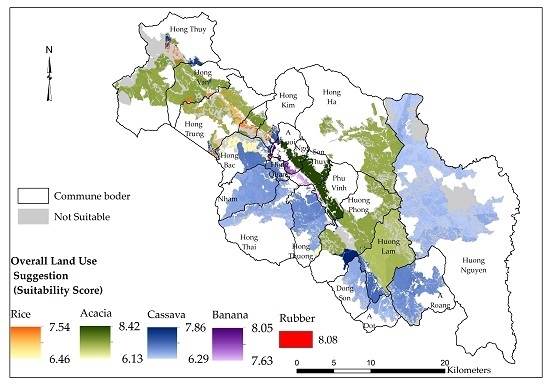Multi-Criteria Decision Analysis for the Land Evaluation of Potential Agricultural Land Use Types in a Hilly Area of Central Vietnam
Abstract
1. Introduction
2. Materials and Methods
2.1. Reseach Area
2.2. Material
2.3. Methods
2.3.1. Participatory Rural Appraisal (PRA)
2.3.2. Criteria Weighting According to Analytical Hierarchy Process (AHP)
- is important level of criterion as compared to criterion
- is important level of criterion as compared to criterion according to expert
- is number of expert involves to discussion
- is normalized value of
- is sum of by column from matrix A
- is number of compared criteria
- is the weight of criterion
- is sum of by row from matrix B
2.3.3. Deriving Scores for Criteria Levels
2.3.4. Suitability Classification
- Si = suitability index for a particular LMU and LUT
- = Score of criterion
2.3.5. GIS Based Land Suitability Evaluation
3. Results
3.1. Selected Crops for Land Suitability Evaluation
3.2. Characteristics of Physical, Economic and social LMUs
3.2.1. Layers of Physical Characteristics
3.2.2. Layers of Economic Characteristics
3.2.3. Layers of Social Characteristics
3.3. Criteria Weights and Scores
3.4. Land Suitability for Selected Land Use Type
3.4.1. Rice
3.4.2. Cassava
3.4.3. Acacia
3.4.4. Banana
3.4.5. Rubber
3.4.6. Overall Land Use Suggestions
4. Discussion
4.1. Land Suitability Evaluation Methodology
4.2. Limiting Factors for Agricultural Production
4.3. Future Perspective on Agriculture in A Luoi district
5. Conclusions
Author Contributions
Funding
Acknowledgments
Conflicts of Interest
References
- United Nations, Department of Economic and Social Affairs, Population Division. World Population Prospects: The 2017 Revision. Key Findings and Advance Tables; United Nations, Department of Economic and Social Affairs, Population Division: New York, NY, USA, 2017. [Google Scholar]
- Food and Agriculture Organization of the United Nations. The State of the World’s Land and Water Resources for Food and Agriculture. Managing Systems at Risk; Food and Agriculture Organization of the United Nations and Earthscan: Abingdon, UK, 2011; ISBN 978-1-84971-326-9. [Google Scholar]
- United Nations, Department for Economic and Social. Sustainable Development Goals Report 2017; United Nations, Department for Economic and Social: New York, NY, USA, 2017; ISBN 978-92-1-101368-9. [Google Scholar]
- Keesstra, S.; Mol, G.; de Leeuw, J.; Okx, J.; Molenaar, C.; de Cleen, M.; Visser, S. Soil-Related Sustainable Development Goals: Four Concepts to Make Land Degradation Neutrality and Restoration Work. Land 2018, 7, 133. [Google Scholar] [CrossRef]
- Kapović Solomun, M.; Barger, N.; Cerda, A.; Keesstra, S.; Marković, M. Assessing land condition as a first step to achieving land degradation neutrality: A case study of the Republic of Srpska. Environ. Sci. Policy 2018, 90, 19–27. [Google Scholar] [CrossRef]
- Ministry of Natural Resources and Environment of Vietnam. The Second Biennial Updated Report of Vietnam to the United Nations Framework Convention on Climate Change; Vietnam Publishing House of Natural Resources, Environment and Cartography: Ha Noi, Vietnam, 2017; ISBN 978-604-952-187-4.
- Food and Agriculture Organization of the United Nations. World Food and Agriculture. Statistical Pocketbook 2018; FAO: Rome, Italy, 2018; ISBN 978-92-5-131012-0. [Google Scholar]
- Quang, C.T.; Chung, T.K. Agricultural Land Policy in the Process of Agriculture & Rural Industrialization and Modernization in Vietnam. 2005. Available online: http://www.chinareform.org/publications/reports/200504/t20050416_111326.htm (accessed on 15 December 2018).
- de la Rosa, D.; van Diepen, C.A. Land Use, Land Cover and Soil Sciences. Qualitative and Quantitative Land Evaluations (Agro-Ecological Land Evaluation); Encyclopedia of Life Support Cultural Organization: Oxford, UK, 2002. [Google Scholar]
- Verheye, W.H. Land Use, Land Cover and Soil Sciences. Land Evaluation; Eolss Publishers Co. Ltd.: Oxford, UK, 2009; ISBN 184826691X. [Google Scholar]
- Ali Asghar, J.; Parisa, A.; Mohamed Reza, N.; Siamak, S. Land Suitability Evaluation of Bilverdy Research Station for Wheat, Barley, Alfalfa, Maize and Safflower. Soil Water Res. 2008, 3, 81–88. [Google Scholar]
- Orhan, D.; Mustafa, U. Multi-criteria approach with linear combination technique and analytical hierarchy process in land evaluation studies. Eurasian J. Soil Sci. 2018, 7, 20–29. [Google Scholar]
- Orhan, D.; Ceyhun, G.; Fatma Esra, S.; Semih, E. Parametric approach to land evaluation for forest plantation: A methodological study using GIS model. Afr。 J. Agric. Res. 2010, 5, 1482–1496. [Google Scholar] [CrossRef]
- van Huynh, C. Multi-Criteria Land Suitability Evaluation for Selected Fruit Crops in Hilly Region of Central Vietnam. With Case Studies in Thua Thien Hue Province; Shaker: Aachen, Germany, 2008; ISBN 3832268464. [Google Scholar]
- Ayla, B.; Fadim, Y.; Aslı, D. AHP and GIS based land suitability analysis for Cihanbeyli (Turkey) County. Environ. Earth Sci. 2016, 75, 813–823. [Google Scholar] [CrossRef]
- Alilou, H.; Rahmati, O.; Singh, V.P.; Choubin, B.; Pradhan, B.; Keesstra, S.; Ghiasi, S.S.; Sadeghi, S.H. Evaluation of watershed health using Fuzzy-ANP approach considering geo-environmental and topo-hydrological criteria. J. Environ. Manag. 2019, 232, 22–36. [Google Scholar] [CrossRef] [PubMed]
- Nguyen, H.H. Evaluation of Coastal Sandy Land in Thanh Hoa province for Agricultural Development with Case study of Quang Xuong district. Ph.D. Thesis, Faculty of Mathematics and Natural Sciences, Greifswald, Germany, 2017. [Google Scholar]
- Tran, D.T. Using GIS and AHP Technique for Land Use Suitability Analysis. In Proceedings of the International Symposium on Geoinformatics for Spatial Infrastructure Development in Earth and Allied Sciences, Ho Chi Minh City, Vietnam, 9–11 November 2006. [Google Scholar]
- Liaghat, M.; Himan, S.; Bashir Rokni, D.; Farshid Sattari, A.; Seyed Navid, S.; Hadi, B. A Multi-Criteria Evaluation using the Analytic Hierarchy Process Technique to Analyze Coastal Tourism Sites. APCBEE Procedia 2013, 5, 479–785. [Google Scholar] [CrossRef]
- Food and Agriculture Organization of the United Nations. Land Evaluation. Towards a Revised Framework; FAO: Rome, Italy, 2007. [Google Scholar]
- Food and Agriculture Organization of the United Nations. Agro-Ecological Zoning. Guidelines; FAO: Rome, Italy, 1996; ISBN 9251038902. [Google Scholar]
- Sys, C.; Van Ranst, E.; Debaveye, J.; Beernaert, F. Land Evaluation. Part III Crop Requirements; Agricultural Publications: Brussels, Belgium, 1993. [Google Scholar]
- Ahmed, S. Evaluation of the land resources for agricultural development. Case study: El-Hammam Canal and Its Extension, NW Coast of Egypt. Ph.D. Thesis, University of Hamburg, Hamburg, Germany, 2013. [Google Scholar]
- Bagherzadeh, A.; Mansouri Daneshvar, M.R. Physical land suitability evaluation for specific cereal crops using GIS at Mashhad Plain, Northeast of Iran. Front. Agric. China 2011, 5, 504–513. [Google Scholar] [CrossRef]
- Shahram, A. Land suitability evaluation for irrigated barley in Damghan plain, Iran. Indian J. Sci. Technol. 2011, 4, 1182–1187. [Google Scholar]
- Abd El-Aziz, S.H. Evaluation of land suitability for main irrigated crops in the North-Western Region of Libya. Eurasian J. Soil Sci. 2018, 7, 73–86. [Google Scholar] [CrossRef]
- Gaiser, T.; Graef, F. Optimisation of a parametric land evaluation method for cowpea and pearl millet production in semiarid regions. Agronomie 2001, 21, 705–712. [Google Scholar] [CrossRef]
- Boje, G.; Rücker, G.; Senzige, S.; Skowronek, A. Skowronek. Land Suitability for Crop Diversification and Yield Potential of Drained Swamp Area in NW-Tanzania. Tropenlandwirt-J. Agric. Trop. Subtrop. 1998, 99, 65–75. [Google Scholar]
- Cools, N.; De Pauw, E.; Deckers, J. Towards an integration of conventional land evaluation methods and farmers’ soil suitability assessment: A case study in northwestern Syria. Agric. Ecosyst. Environ. 2003, 95, 327–342. [Google Scholar] [CrossRef]
- Zurayk, R.; el-Awar, F.; Hamadeh, S.; Talhouk, S.; Sayegh, C.; Chehab, A.-G.; Shab, K.A. Using indigenous knowledge in land use investigations: A participatory study in a semi-arid mountainous region of Lebanon. Agric. Ecosyst. Environ. 2001, 86, 247–262. [Google Scholar] [CrossRef]
- Buthelezi, N.N.; Hughes, J.C.; Modi, A.T. The use of scientific and indigenous knowledge in agricultural land evaluation and soil fertility studies of two villages in KwaZulu-Natal, South Africa. Afr. J. Agric. Res. 2013, 8, 507–518. [Google Scholar] [CrossRef]
- Davidson, D.A.; Theocharopoulos, S.P.; Bloksma, R.J. A land evaluation project in Greece using GIS and based on Boolean and fuzzy set methodologies. Int. J. Geogr. Inf. Syst. 1994, 8, 369–384. [Google Scholar] [CrossRef]
- Shalaby, A.; AbdelRahman, M.A.E.; Belal, A.A. A GIS Based Model for Land Evaluation Mapping: A Case Study North Delta Egypt. Egyptian J. Soil Sci. 2017, 57, 339–351. [Google Scholar] [CrossRef][Green Version]
- Malczewski, J. GIS-based multicriteria decision analysis: A survey of the literature. Int. J. Geogr. Inf. Syst. 2006, 20, 703–726. [Google Scholar] [CrossRef]
- Joerin, F.; Thériault, M.; Musy, A. Using GIS and outranking multicriteria analysis for land-use suitability assessment. Int. J. Geogr. Inf. Syst. 2001, 15, 153–174. [Google Scholar] [CrossRef]
- Aldababseh, A.; Temimi, M.; Maghelal, P.; Branch, O.; Wulfmeyer, V. Multi-Criteria Evaluation of Irrigated Agriculture Suitability to Achieve Food Security in an Arid Environment. Sustainability 2018, 10, 803. [Google Scholar] [CrossRef]
- People’s Committee of A Luoi District. Statistical Year Book: 2005–2015; People’s Committee of A Luoi District: Thua Thien Hue, Vietnam, 2015.
- Food and Agriculture Organization of the United Nations. World Reference Base for Soil Resources 2014. International Soil Classification System for Naming Soils and Creating Legends for Soil Maps; FAO: Rome, Italy, 2014; ISBN 978-92-5-108369-7. [Google Scholar]
- National Institute of Agricultural Planning and Projection of Vietnam. Soil Map of Thua Thien Hue Province (1/100000); National Institute of Agricultural Planning and Projection of Vietnam: Ha Noi, Vietnam, 2005. [Google Scholar]
- Natural Resources and Environment Department of A Luoi District. Land Use Map of A Luoi District, Thua Thien Hue province, (1/50000); Natural Resources and Environment Department of A Luoi District: Thua Thien Hue, Vietnam, 2015.
- Elsheikh, R.; Mohamed Shariff, A.R.B.; Amiri, F.; Ahmad, N.B.; Balasundram, S.K.; Soom, M.A.M. Agriculture Land Suitability Evaluator (ALSE): A decision and planning support tool for tropical and subtropical crops. Comput. Electron. Agric. 2013, 93, 98–110. [Google Scholar] [CrossRef]
- Gia Pham, T.; Kappas, M.; van Huynh, C.; Hoang Khanh Nguyen, L. Application of Ordinary Kriging and Regression Kriging Method for Soil Properties Mapping in Hilly Region of Central Vietnam. ISPRS Int. J. Geo-Inf. 2019, 8, 147. [Google Scholar] [CrossRef]
- United States Geological Survey (USGS). Digital Elevation—Shuttle Radar Topography Mission (SRTM) 1 Arc-Second Global; Raster; 2000. Available online: https://earthexplorer.usgs.gov/ (accessed on 1 June 2018).
- Thua Thien Hue Meteorological Station. Hydrometeorolical Annual Reports from 2005 to 2017; Thua Thien Hue Publishing House: Hue city, Vietnam, 2017. [Google Scholar]
- Paul, R. Participatory Rural Appraisal (PRA) Manual; FAO: Castries, Saint Lucia, 2013. [Google Scholar]
- Saaty, R.W. The analytic hierarchy process—What it is and how it is used. Math. Model. 1987, 9, 161–176. [Google Scholar] [CrossRef]
- Ahmed, G.B.; Shariff, A.R.M.; Balasundram, S.K.; Fikri bin Abdullah, A. Agriculture land suitability analysis evaluation based multi criteria and GIS approach. IOP Conf. Ser. Earth Environ. Sci. 2016, 37, 12044. [Google Scholar] [CrossRef]
- Akıncı, H.; Özalp, A.Y.; Turgut, B. Agricultural land use suitability analysis using GIS and AHP technique. Comput. Electron. Agric. 2013, 97, 71–82. [Google Scholar] [CrossRef]
- Das, P.T.; Sudhakar, S. Land Suitability Analysis for Orange & Pineapple: A Multi Criteria Decision Making Approach Using Geo Spatial Technology. J. Geogr. Inf. Syst. 2014, 06, 40–44. [Google Scholar] [CrossRef][Green Version]
- Wang, Z.; Deng, X.; Song, W.; Li, Z.; Chen, J. What is the main cause of grassland degradation? A case study of grassland ecosystem service in the middle-south Inner Mongolia. CATENA 2017, 150, 100–107. [Google Scholar] [CrossRef]
- Saaty, T.L. Decision making with the analytic hierarchy process. Int. J. Serv. Sci. 2008, 1, 83–98. [Google Scholar] [CrossRef]
- Nguyen, T.T.; Verdoodt, A.; Van, T.Y.; Delbecque, N.; Tran, T.C.; van Ranst, E. Design of a GIS and multi-criteria based land evaluation procedure for sustainable land-use planning at the regional level. Agric. Ecosyst. Environ. 2015, 200, 1–11. [Google Scholar] [CrossRef]
- Food and Agriculture Organization of the United Nations. A Framework for Land Evaluation; Food and Agriculture Organization of the United Nations: Rome, Italy, 1976; ISBN 92-5-100111-1. [Google Scholar]
- AbdelRahman, M.A.E.; Natarajan, A.; Hegde, R. Assessment of land suitability and capability by integrating remote sensing and GIS for agriculture in Chamarajanagar district, Karnataka, India. Egypt. J. Remote Sens. Space Sci. 2016, 19, 125–141. [Google Scholar] [CrossRef]
- El Baroudy, A.A. Mapping and evaluating land suitability using a GIS-based model. CATENA 2016, 140, 96–104. [Google Scholar] [CrossRef]
- Dan, N.N.; Ping, L.G.; Le Lang, P.C. Land Unit Mapping and Evaluation of Land Suitability for Agro—forestrye in Thua Thien Hue province—VietNam as an Example. IOP Conf. Ser. Earth Environ. Sci. 2018, 159, 12012. [Google Scholar] [CrossRef]
- Zolekar, R.B.; Bhagat, V.S. Multi-criteria land suitability analysis for agriculture in hilly zone: Remote sensing and GIS approach. Comput. Elecyron. Agric. 2015, 118, 300–321. [Google Scholar] [CrossRef]
- Mu, E.; Pereyra-Rojas, M. Practical Decision Making Using Super Decisions V3. An Introduction to the Analytic Hierarchy Process; Springer: Cham, Germany, 2017; ISBN 9783319683683. [Google Scholar]
- Ossadnik, W.; Schinke, S.; Kaspar, R.H. Group Aggregation Techniques for Analytic Hierarchy Process and Analytic Network Process: A Comparative Analysis. Group Dec. Negot. 2016, 25, 421–457. [Google Scholar] [CrossRef]
- Saaty, T.L.; Peniwati, K. Group Decision Making. Drawing out and Reconciling Differences, Revised edition; RWS Publications: Pittsburgh, PA, USA, 2012; ISBN 1888603089. [Google Scholar]
- Lee, J.; Gereffi, G.; Beauvais, J. Global value chains and agrifood standards: challenges and possibilities for smallholders in developing countries. Proc. Natl. Acad. Sci. USA 2012, 109, 12326–12331. [Google Scholar] [CrossRef] [PubMed]
- Yen, B.T.; Visser, S.M.; Hoanh, C.T.; Stroosnijder, L. Constraints on Agricultural Production in the Northern Uplands of Vietnam. Mt. Res. Dev. 2013, 33, 404–415. [Google Scholar] [CrossRef]
- Pereira, J.M.C.; Duckstein, L. A multiple criteria decision-making approach to GIS-based land suitability evaluation. Int. J. Geogr. Inf. Syst. 1993, 7, 407–424. [Google Scholar] [CrossRef]
- Nisar Ahamed, T.R.; Gopal Rao, K.; Murthy, J.S.R. GIS-based fuzzy membership model for crop-land suitability analysis. Agric. Syst. 2000, 63, 75–95. [Google Scholar] [CrossRef]
- Zadeh, L.A. Similarity relations and fuzzy orderings. Inf. Sci. 1971, 3, 177–200. [Google Scholar] [CrossRef]
- Joss, B.N.; Hall, R.J.; Sidders, D.M.; Keddy, T.J. Fuzzy-logic modeling of land suitability for hybrid poplar across the Prairie Provinces of Canada. Environ. Monit. Assess. 2008, 141, 79–96. [Google Scholar] [CrossRef]
- Malczewski, J. GIS-based land-use suitability analysis: A critical overview. Prog. Plan. 2004, 62, 3–65. [Google Scholar] [CrossRef]
- Clemens, G.; Fiedler, S.; Cong, N.D.; van Dung, N.; Schuler, U.; Stahr, K. Soil fertility affected by land use history, relief position, and parent material under a tropical climate in NW-Vietnam. CATENA 2010, 81, 87–96. [Google Scholar] [CrossRef]
- Thomas, H.; Alwin, K.; Melvin, L.; Mattiga, P.; Camille, S.-M.; Manfred, Z.; Wanwisa, P.; Tuan, V.D.; Georg, C. Soil Conservation on Sloping Land: Technical Options and Adoption Constraints. In Sustainable Land Use and Rural Development in Southeast Asia: Innovations and Policies for Mountainous Areas; Fröhlich, H.L., Schreinemachers, P., Stahr, K., Clemens, G., Eds.; Springer: Berlin/Heidelberg, Germany, 2013; pp. 229–279. ISBN 978-3-642-33376-7. [Google Scholar]
- Zeller, M.; Ufer, S.; Van, D.T.T.; Nielsen, T.; Schreinemachers, P.; Tipraqsa, P.; Berger, T.; Saint-Macary, C.; Van, L.T.A.; Keil, A.; et al. Policies for Sustainable Development: The Commercialization of Smallholder Agriculture. In Sustainable Land Use and Rural Development in Southeast Asia: Innovations and Policies for Mountainous Areas; Springer: Berlin/Heidelberg, Germany; pp. 463–490.
- Maraseni, T.N.; Son, H.L.; Cockfield, G.; Duy, H.V.; Nghia, T.D. Comparing the financial returns from acacia plantations with different plantation densities and rotation ages in Vietnam. For. Policy Econ. 2017, 83, 80–87. [Google Scholar] [CrossRef]
- Fox, J.; Castella, J.-C.; Ziegler, A.D.; Westley, S.B. Rubber Plantations Expand in Mountainous Southeast Asia: What Are the Consequences for the Environment? 2014. Available online: https://www.eastwestcenter.org/system/tdf/private/api114.pdf?file=1&type=node&id=34563 (accessed on 15 September 2018).
- To, X.P.; Tran, H.N. Rubber Expansion and Forest Protection in Vietnam; Tropenbos International Viet Nam: Hue, Vietnam, 2014. [Google Scholar]
- Nguyen, T.T.H. Solutions to improve the value added of the rubber value chain in the Central Highlands of Vietnam. Australas. Agribus. Persp. 2018, 21, 89–97. [Google Scholar]
- Van de Fliert, E.; Pham, T.V.; Do, T.M.H.; Thomas, P.; Nicetic, O. Out of comfort zones, into realities: research for development with upland ethnic minority communities in North West Vietnam. In Building Sustainable Rural Futures, The added Value of Systems Approaches in Times of Change and Uncertainty, Proceedings of the 9th European IFSA Symposium, Vienna, Austria, 4–7 July 2010; Darnhofer, I., Michaela, G., Eds.; BOKU: Wien, Austria, 2010; pp. 330–342. ISBN 978-3-200-01908-9. [Google Scholar]
- World Bank. Vietnam Development Report 2016. Transforming Vietnamese Agriculture: Gaining More from Less; Hong Duc Publishing House: Ha Noi, Vietnam, 2016; ISBN 978-604-948-014-0. [Google Scholar]
- Alwin, K.; Camille, S.-M.; Manfred, Z. Intensive Commercial Agriculture in Fragile Uplands of Vietnam: How to Harness its Poverty Reduction Potential while Ensuring Environmental Sustainability? Q. J. Int. Agric. 2013, 52, 1–25. [Google Scholar]
- Tran, T.H.M.; Nguyen, T.H.Y. Vietnam’s Agriculture towards Sustainable Development: Opportunities, Challenges and Solutions in the context of International Economic Integration nowadays. South East Asia J. Contemp. Bus. Econ. Law 2018, 15, 63–70. [Google Scholar]
- People’s Committee of A Luoi District. The draft land use plan of the A Luoi district in 2030. 2018; Unpublished work. [Google Scholar]
- Nguyen, H.Q. Analyzing the economies of crop diversification in rural Vietnam using an input distance function. Agric. Syst. 2017, 153, 148–156. [Google Scholar] [CrossRef]
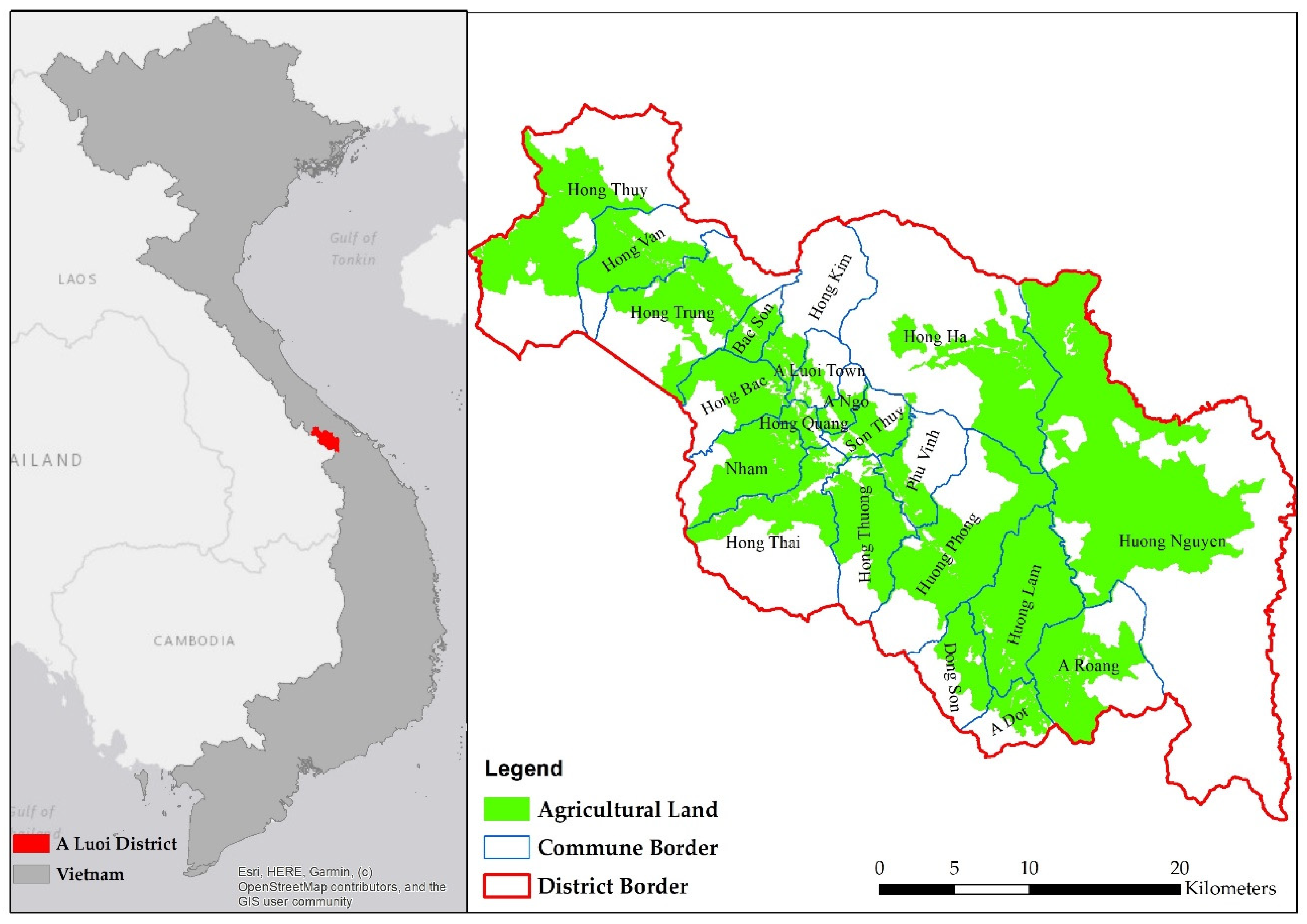
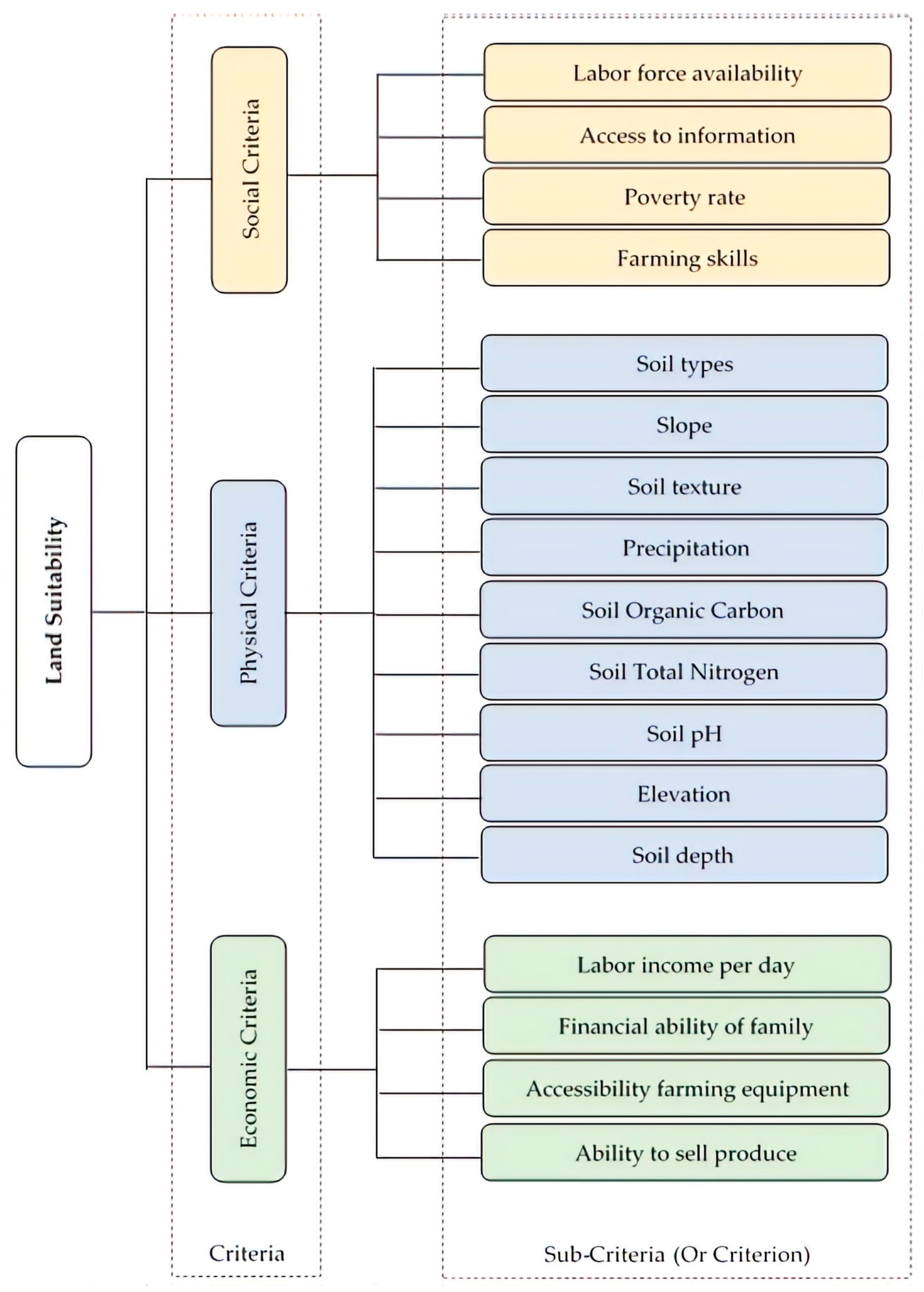
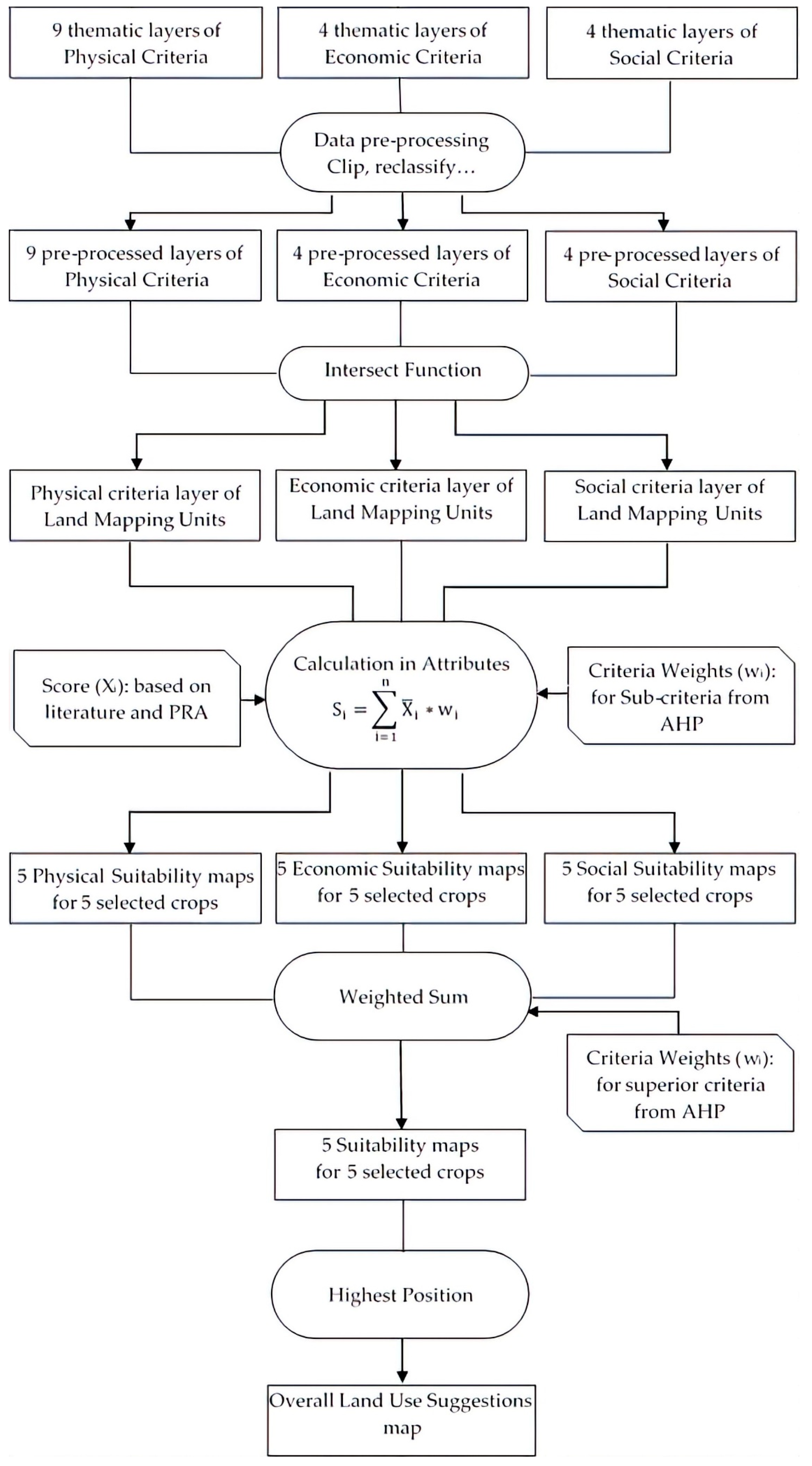
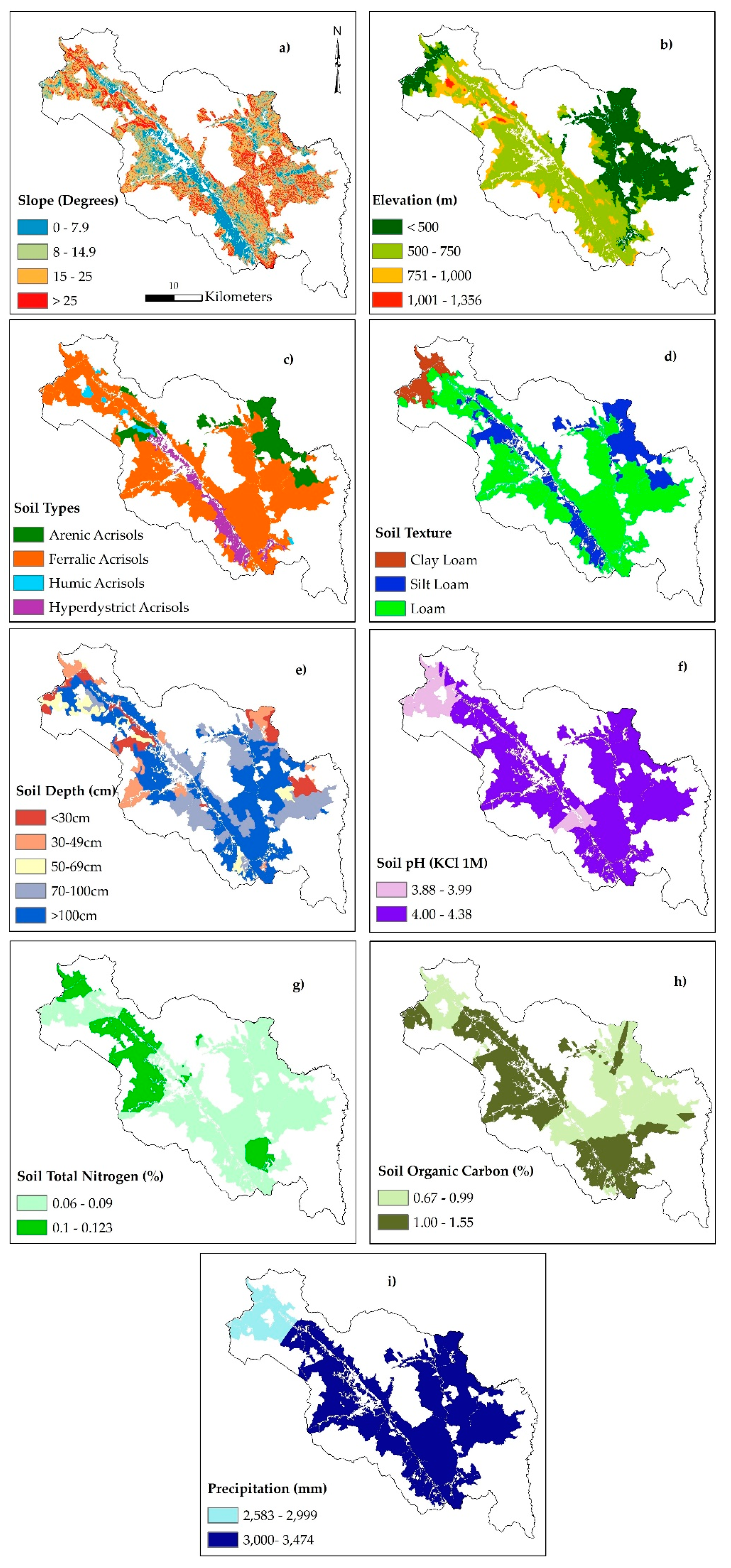
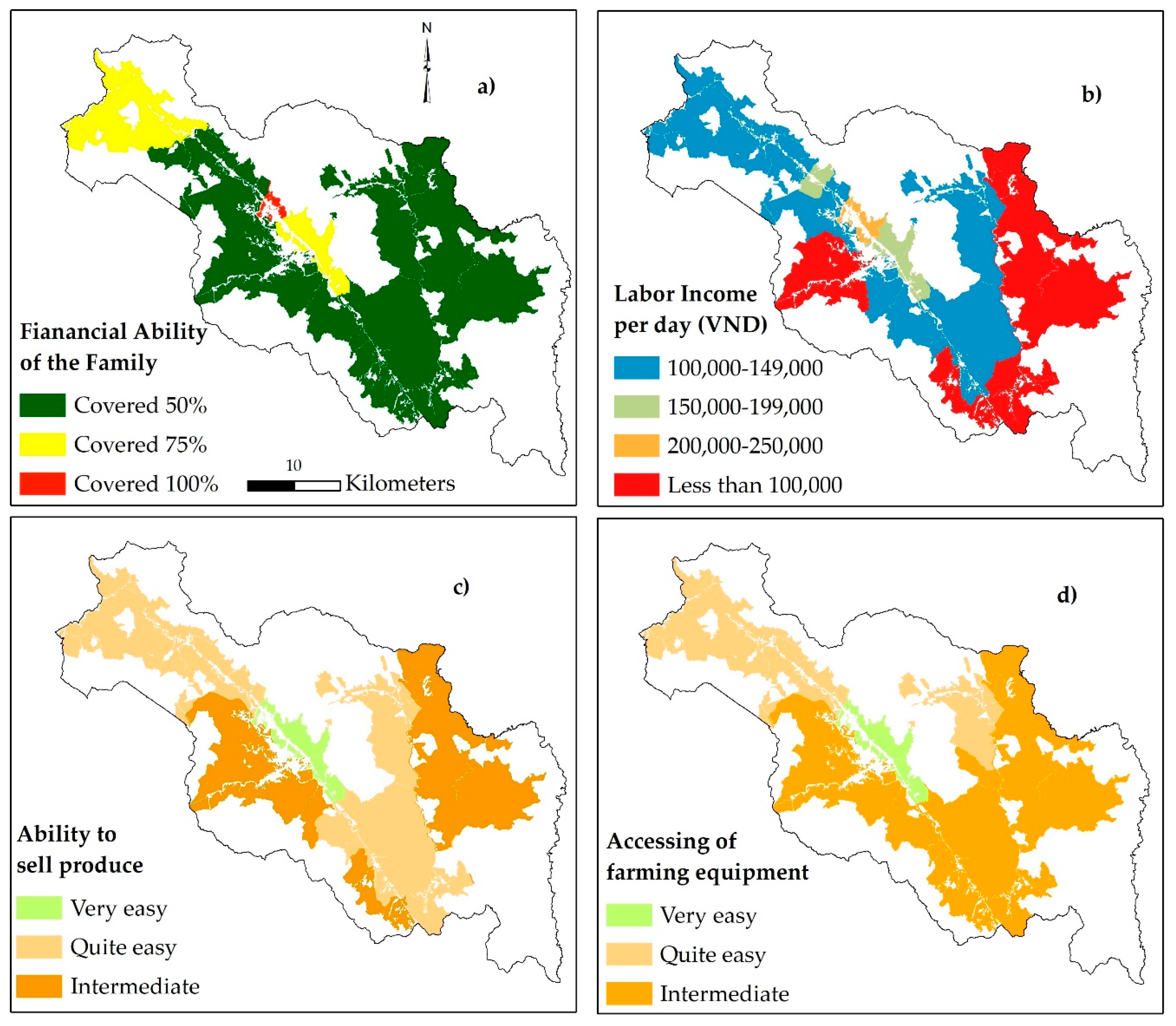
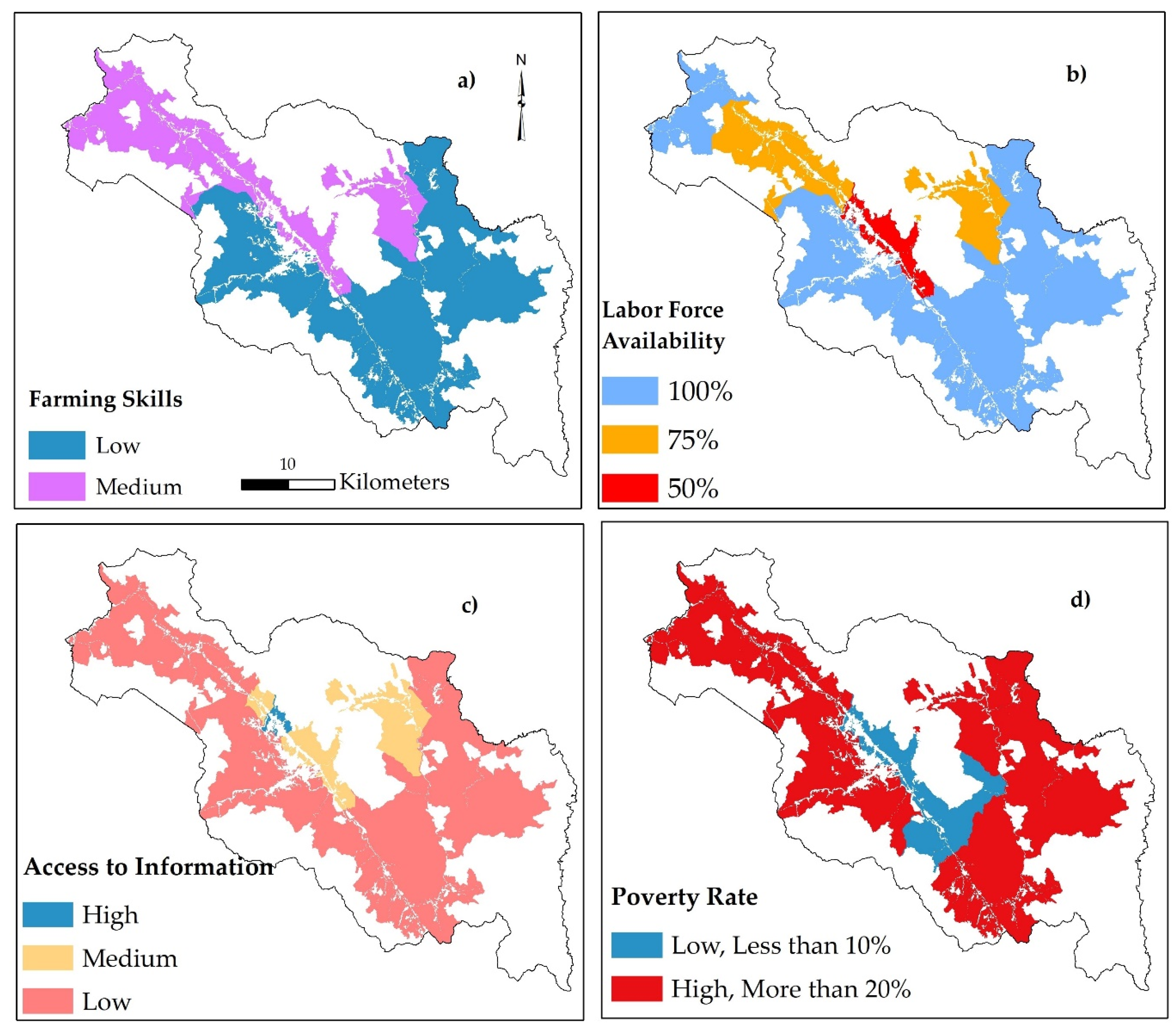
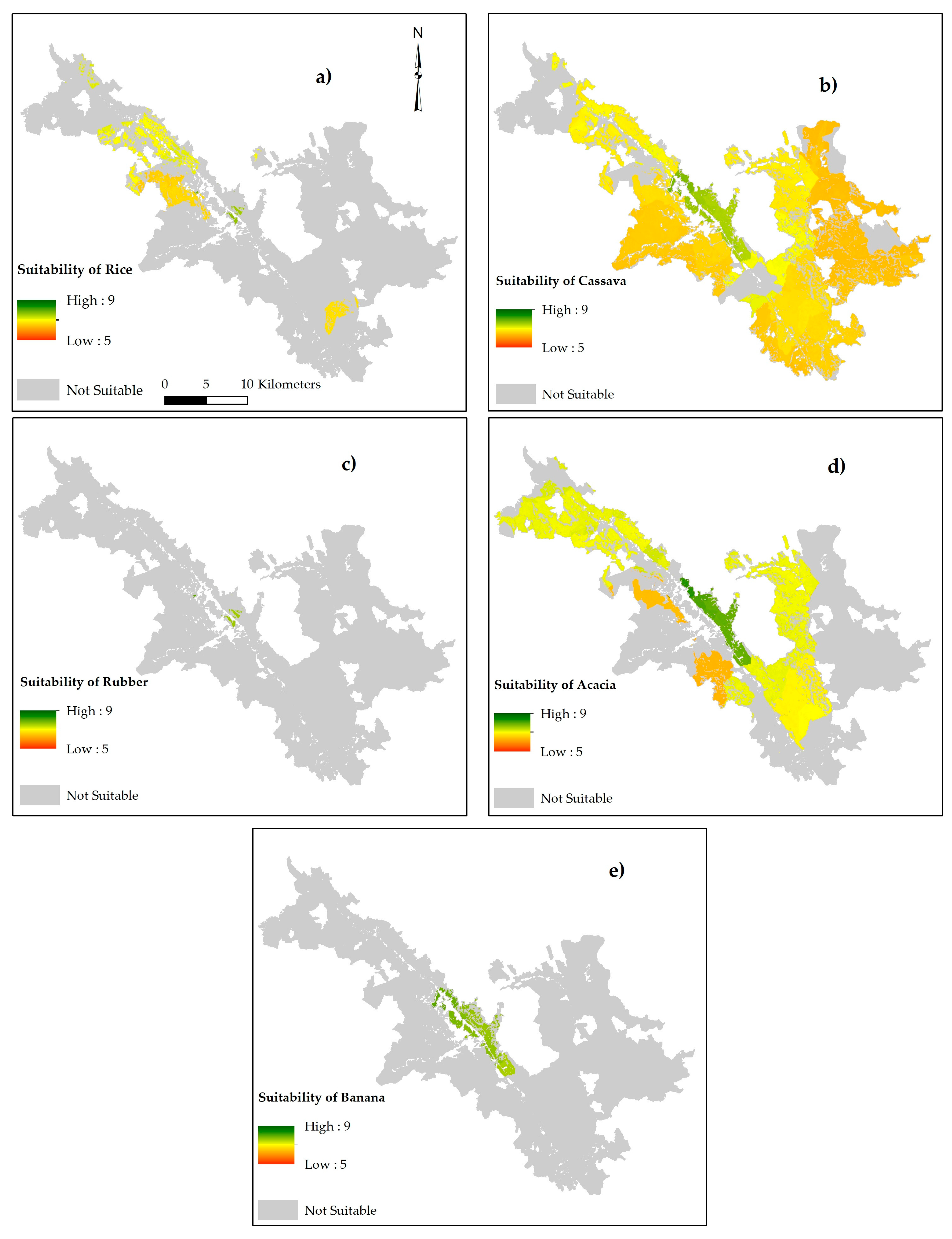
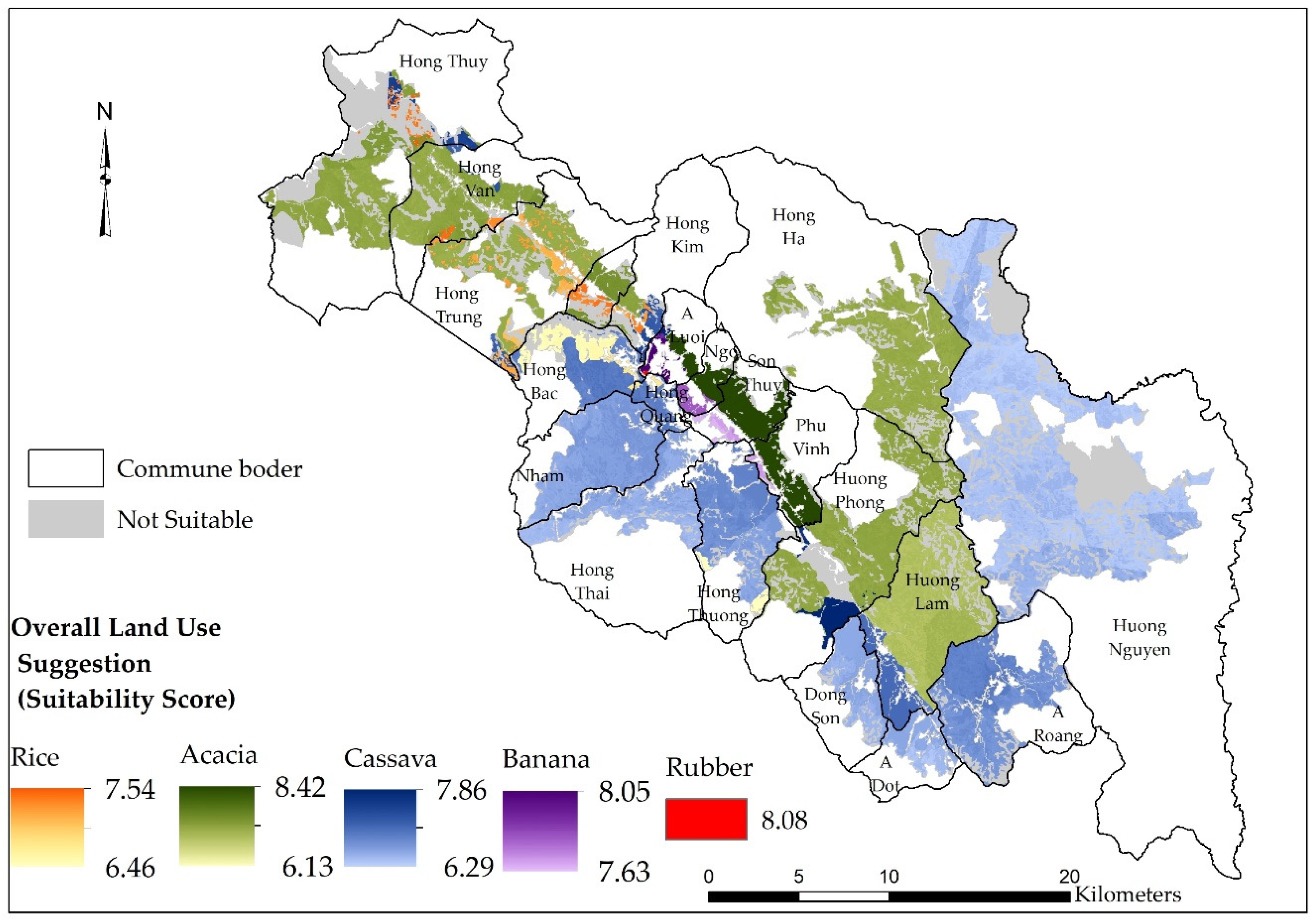
| Criteria | Data Source | Map Method |
|---|---|---|
| Physical Criteria | ||
| Soil type Soil depth Soil texture | Soil map of Thua Thien Hue province (1:100,000) issued by NIAPP in 2005 [39]. | Convert from Mapinfo format (Tab) to ESRI format (Shp) |
| Soil organic carbon Soil total nitrogen Soil pH | Soil survey data of 155 soil sampling [42]. | Ordinary kriging (resolution at 30 m) |
| Elevation Slope | Digital Elevation Model (DEM), resolution at 30 m [43]. | Original data |
| Precipitation | Average annual precipitation from 2005 to 2017 based on three meteorological station in Thua Thua Hue province [44]. | Inverse Distance Weighting (resolution at 30 m) |
| Economic Criteria | ||
| Financial ability of family | Group discussion/Participatory GIS and Statistical data [37] | Community-wise |
| Accessibility of farming equipment | ||
| Labor income per day | ||
| Ability to sell product | ||
| Social Criteria | ||
| Poverty rate | Individual discussion/ Participatory GIS Statistical data [37] | Community-wise |
| Labor force availability | ||
| Access to information | ||
| Farming skills | ||
| Participants from | Number of Participants | ||||||||||||||||
|---|---|---|---|---|---|---|---|---|---|---|---|---|---|---|---|---|---|
| Outside Experts | Group Discussion for Crops Selection | Online and Individual Discussion for Physical requirements | 9 | Group Discussion for Economic requirements | Individual Discussion for Social requirement | ||||||||||||
| Local Experts | 21 | ||||||||||||||||
| District’s Agriculture and Rural Development Dept. | 1 | 1 | |||||||||||||||
| Hue University of Agriculture and Forestry | 1 | 2 | 1 | ||||||||||||||
| District’s People Committee | 1 | 1 | |||||||||||||||
| Hue University of Economy | 2 | ||||||||||||||||
| Natural Resources and Environment Dept. | 1 | 1 | |||||||||||||||
| District’s Labor and Social Dept. | 1 | 1 | |||||||||||||||
| District’s Commerce Dept. | 1 | 1 | |||||||||||||||
| Commune’s People Committee | 1 | 1 | 1 | 1 | 1 | 1 | 1 | ||||||||||
| Commune’s Agricultural Dept. | 1 | 1 | 1 | 1 | 1 | 1 | |||||||||||
| Farmers | 3 | 3 | 3 | 3 | 3 | 3 | |||||||||||
| Agricultural Companies | 1 | ||||||||||||||||
| Small Traders | 2 | ||||||||||||||||
| Center Rural Development in Central Vietnam | 1 | ||||||||||||||||
| Farmer’s Union | 1 | ||||||||||||||||
| Total | 21 | 3 | 3 | 5 | 5 | 5 | 30 | 30 | 27 | 5 | 5 | 5 | 5 | 4 | 3 | 4 | 4 |
| Numeric Scale | Response Alternatives of Experts |
|---|---|
| 9 | Criterion is extremely more important than criterion |
| 7 | Criterion is strongly more important than criterion |
| 5 | Criterion is more important than criterion |
| 3 | Criterion is slightly more important than criterion |
| 1 | Criteria is equally important as criterion |
| 1/3 | Criterion is slightly less important than criterion |
| 1/5 | Criterion is less important than criterion |
| 1/7 | Criterion is strongly less important than criterion |
| 1/9 | Criterion is extremely less important than criterion |
| n | 1 | 2 | 3 | 4 | 5 | 6 | 7 | 8 | 9 | 10 |
|---|---|---|---|---|---|---|---|---|---|---|
| RI | 0 | 0 | 0.58 | 0.90 | 1.12 | 1.24 | 1.32 | 1.41 | 1.45 | 1.49 |
| Score () | Definition |
|---|---|
| 9 | Criterion is suitable for evaluated LUT without any concerns. |
| 7 | Criterion is suitable for evaluated LUT with few concerns. |
| 5 | Criterion may be suitable for evaluated LUT with many concerns. |
| 3 | Criterion is unsuitable for evaluated LUT. |
| PRA | Literature | Definition |
|---|---|---|
| 8–9 | S1(0) | Suitability of LMU is high and satisfies all considered criteria. |
| 7–8 | S1(1) | Suitability of LMU is high and satisfies most important considered criteria. |
| 6–7 | S2 | Suitability of LMU is medium and satisfies most considered criteria, but some criteria are not satisfied. |
| 5–6 | S3 | Suitability of LMU is low and satisfies some considered criteria, but most considered criteria are not satisfied. |
| Less than 5 | N | Not Suitable |
| Physical Conditions | Economic Conditions | Social Conditions | Total | Final Rank | |
|---|---|---|---|---|---|
| Acacia | 0.136 | 0.172 | 0.045 | 0.353 | 1 |
| Cassava | 0.081 | 0.142 | 0.029 | 0.252 | 2 |
| Rice | 0.048 | 0.096 | 0.025 | 0.168 | 3 |
| Rubber | 0.032 | 0.043 | 0.008 | 0.084 | 4 |
| Banana | 0.027 | 0.036 | 0.007 | 0.070 | 5 |
| Vegetables | 0.016 | 0.021 | 0.006 | 0.044 | 6 |
| Coffee | 0.012 | 0.014 | 0.003 | 0.030 | 7 |
| (Sub-)Criterion/LUTs | Rice | Cassava | Acacia | Rubber | Banana | ||||||
|---|---|---|---|---|---|---|---|---|---|---|---|
| Physical | Soil type | 0.36 | 0.18 | 0.32 | 0.13 | 0.28 | 0.17 | 0.25 | 0.13 | 0.27 | 0.14 |
| Slope | 0.06 | 0.06 | 0.11 | 0.07 | 0.05 | ||||||
| Soil Texture | 0.15 | 0.07 | 0.08 | 0.08 | 0.10 | ||||||
| Precipitation | 0.14 | 0.06 | 0.05 | 0.05 | 0.04 | ||||||
| Soil Organic Carbon | 0.17 | 0.24 | 0.17 | 0.26 | 0.27 | ||||||
| Soil Total Nitrogen | 0.13 | 0.22 | 0.17 | 0.19 | 0.22 | ||||||
| Soil pH | 0.09 | 0.07 | 0.08 | 0.05 | 0.05 | ||||||
| Elevation | 0.04 | 0.05 | 0.06 | 0.05 | 0.05 | ||||||
| Soil Depth | 0.04 | 0.09 | 0.12 | 0.13 | 0.09 | ||||||
| Economic | Labor income per day | 0.18 | 0.18 | 0.38 | 0.33 | 0.55 | 0.24 | 0.58 | 0.18 | 0.59 | 0.13 |
| Financial ability of the family | 0.25 | 0.32 | 0.17 | 0.20 | 0.15 | ||||||
| Accessibility of farming equipment | 0.41 | 0.21 | 0.08 | 0.10 | 0.09 | ||||||
| Ability to sell produce | 0.16 | 0.13 | 0.51 | 0.51 | 0.62 | ||||||
| Social | Labor Force Availability | 0.47 | 0.45 | 0.30 | 0.33 | 0.17 | 0.32 | 0.18 | 0.18 | 0.14 | 0.28 |
| Access to Information | 0.20 | 0.17 | 0.23 | 0.19 | 0.15 | ||||||
| Poverty rate | 0.23 | 0.38 | 0.36 | 0.41 | 0.30 | ||||||
| Farming skills | 0.11 | 0.11 | 0.08 | 0.22 | 0.27 | ||||||
| PRA Scoring | Literature Scoring | ||||||||
|---|---|---|---|---|---|---|---|---|---|
| Criterion and Level | Rice | Cassava | Acacia | Rubber | Banana | Rice | Cassava | Rubber | Banana |
| Soil depth (cm) | |||||||||
| <30 cm | 7.20 | 4.79 | 4.22 | 3.23 | 3.00 | 4 | 3.5 | 3.5 | 3.5 |
| 30–49 cm | 9.00 | 7.45 | 5.00 | 3.47 | 4.79 | 5.5 | 3.5 | 3.5 | 5.5 |
| 50–69 cm | 6.43 | 7.45 | 7.00 | 5.78 | 6.85 | 6.5 | 5.5 | 5.5 | 6.5 |
| 70–100 cm | 6.93 | 5.44 | 7.61 | 7.80 | 7.45 | 7 | 6.5 | 5.5 | 7.5 |
| >100 cm | 7.00 | 5.00 | 7.61 | 8.08 | 8.45 | 8 | 8 | 7 | 8.5 |
| Soil texture | |||||||||
| Silt loam | 6.50 | 7.30 | 7.61 | 7.52 | 7.30 | 8.5 | 7.5 | 7.5 | 8.5 |
| Loam | 7.33 | 6.85 | 7.20 | 6.83 | 7.94 | 7.5 | 7.5 | 7.5 | 7.5 |
| Clay loam | 6.14 | 4.79 | 6.17 | 5.78 | 7.45 | 8.5 | 7.5 | 8.5 | 8.5 |
| Elevation (m) | |||||||||
| <500 | 9.00 | 7.94 | 8.63 | 8.38 | 8.45 | No Information | |||
| 501–750 | 7.20 | 7.00 | 9.00 | 7.26 | 7.94 | ||||
| 751–1000 | 5.59 | 6.44 | 8.28 | 6.36 | 5.92 | ||||
| >1000 | 3.76 | 5.00 | 5.92 | 4.32 | 3.87 | ||||
| Slope (°) | |||||||||
| 0–7.9 | 8.20 | 9.00 | 6.80 | 8.38 | 8.45 | 7 | 7 | 7 | 7 |
| 8–14.9 | 4.72 | 7.00 | 8.63 | 7.26 | 7.45 | 5.5 | 5.5 | 5.5 | 5.5 |
| 15–25 | 3.58 | 5.72 | 7.61 | 5.47 | 4.66 | 3.5 | 4.5 | 4.5 | 4.5 |
| >25 | 3.09 | 3.44 | 4.90 | 3.12 | 3.21 | 3.5 | 3.5 | 3.5 | 3.5 |
| Soil total nitrogen (%) | |||||||||
| <0.1 | 4.72 | 5.44 | 5.92 | 3.73 | 5.44 | No Information | |||
| 0.1–0.15 | 5.81 | 6.30 | 7.61 | 5.50 | 5.79 | ||||
| Soil organic carbon (%) | |||||||||
| 0.5–0.99 | 5.28 | 7.00 | 6.90 | 4.76 | 5.44 | 6 | 6.5 | 8 | 6 |
| 1.0–1.5 | 6.43 | 7.94 | 7.61 | 6.59 | 7.45 | 6.5 | 7.5 | 8 | 6.5 |
| Soil pH | |||||||||
| 3.5–3.99 | 3.76 | 4.79 | 6.90 | 4.65 | 4.40 | 4.5 | 4.5 | 4.5 | 4.5 |
| 4.0–4.5 | 5.97 | 6.44 | 7.61 | 6.06 | 5.92 | 4.5 | 4.5 | 5.5 | 4.5 |
| Soil type | |||||||||
| Acrisol (Humic) | 6.13 | 6.85 | 7.61 | 6.67 | 7.45 | No Information | |||
| Acrisol (Arenic) | 5.28 | 6.44 | 7.30 | 6.36 | 7.00 | ||||
| Acrisol (Hyperdystric) | 6.67 | 6.85 | 4.72 | 6.36 | 7.94 | ||||
| Acrisol (Ferralic) | 5.18 | 7.00 | 6.90 | 6.83 | 5.44 | ||||
| Precipitation (mm/year) | |||||||||
| 2500–2999 | 7.26 | 7.30 | 8.28 | 7.52 | 7.00 | 6.5 | 6.5 | 8.5 | 8.5 |
| 3000–3500 | 6.43 | 7.30 | 7.30 | 6.36 | 5.92 | 6.5 | 6.5 | 8.5 | 8.5 |
| Labor income per day (VND) * | |||||||||
| 200,000–250,000 | 8.68 | 8.63 | 9.00 | 8.08 | 8.28 | No Information | |||
| 150,000–199,000 | 8.68 | 7.61 | 8.14 | 6.36 | 7.00 | ||||
| 100,000–149,000 | 6.36 | 5.92 | 6.43 | 4.02 | 4.86 | ||||
| <100,000 | 4.53 | 4.22 | 5.35 | 3.00 | 3.27 | ||||
| Financial ability of the family | |||||||||
| Covered 100% | 9.00 | 9.00 | 9.00 | 9.00 | 9.00 | No Information | |||
| Covered 75% | 8.08 | 7.30 | 8.14 | 7.52 | 7.50 | ||||
| Covered 50% | 6.92 | 5.59 | 7.24 | 6.06 | 4.92 | ||||
| Accessibility of farming equipment | |||||||||
| Very easy | 9.00 | 9.00 | 9.00 | 9.00 | 9.00 | No Information | |||
| Quite easy | 7.80 | 8.63 | 8.56 | 7.00 | 7.50 | ||||
| Intermediate | 6.06 | 6.62 | 6.12 | 5.25 | 4.72 | ||||
| Ability to sell produce | |||||||||
| Very easy | 9.00 | 9.00 | 9.00 | 9.00 | 8.63 | No Information | |||
| Quite easy | 8.68 | 7.61 | 9.00 | 7.00 | 6.26 | ||||
| Intermediate | 7.17 | 5.43 | 7.00 | 3.92 | 4.10 | ||||
| Labor force availability | |||||||||
| 100% | 9.00 | 8.45 | 9.00 | 9.00 | 9.00 | No Information | |||
| 75% | 7.94 | 7.00 | 8.45 | 7.45 | 8.45 | ||||
| 50% | 5.92 | 5.92 | 6.44 | 5.44 | 7.45 | ||||
| Poverty rate | |||||||||
| High (>20%) | 5.92 | 5.44 | 5.44 | 3.41 | 3.41 | No Information | |||
| Low (<10%) | 9.00 | 9.00 | 9.00 | 7.00 | 7.94 | ||||
| Farming skills | |||||||||
| Medium | 7.45 | 7.45 | 7.94 | 7.00 | 6.44 | No Information | |||
| Low | 5.92 | 5.92 | 6.44 | 3.87 | 3.87 | ||||
| Access to Information | |||||||||
| High | 9.00 | 9.00 | 9.00 | 9.00 | 8.45 | No Information | |||
| Medium | 6.85 | 7.45 | 7.45 | 6.44 | 7.00 | ||||
| Low | 5.44 | 5.92 | 5.21 | 3.87 | 4.79 | ||||
© 2019 by the authors. Licensee MDPI, Basel, Switzerland. This article is an open access article distributed under the terms and conditions of the Creative Commons Attribution (CC BY) license (http://creativecommons.org/licenses/by/4.0/).
Share and Cite
Herzberg, R.; Pham, T.G.; Kappas, M.; Wyss, D.; Tran, C.T.M. Multi-Criteria Decision Analysis for the Land Evaluation of Potential Agricultural Land Use Types in a Hilly Area of Central Vietnam. Land 2019, 8, 90. https://doi.org/10.3390/land8060090
Herzberg R, Pham TG, Kappas M, Wyss D, Tran CTM. Multi-Criteria Decision Analysis for the Land Evaluation of Potential Agricultural Land Use Types in a Hilly Area of Central Vietnam. Land. 2019; 8(6):90. https://doi.org/10.3390/land8060090
Chicago/Turabian StyleHerzberg, Ronja, Tung Gia Pham, Martin Kappas, Daniel Wyss, and Chau Thi Minh Tran. 2019. "Multi-Criteria Decision Analysis for the Land Evaluation of Potential Agricultural Land Use Types in a Hilly Area of Central Vietnam" Land 8, no. 6: 90. https://doi.org/10.3390/land8060090
APA StyleHerzberg, R., Pham, T. G., Kappas, M., Wyss, D., & Tran, C. T. M. (2019). Multi-Criteria Decision Analysis for the Land Evaluation of Potential Agricultural Land Use Types in a Hilly Area of Central Vietnam. Land, 8(6), 90. https://doi.org/10.3390/land8060090






